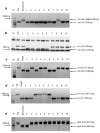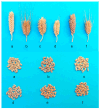Allelic Variations in Phenology Genes in Club Wheat (Triticum compactum) and Their Association with Heading Date
- PMID: 40430014
- PMCID: PMC12112085
- DOI: 10.3390/ijms26104875
Allelic Variations in Phenology Genes in Club Wheat (Triticum compactum) and Their Association with Heading Date
Abstract
The allelic diversity within genes controlling the vernalization requirement (VRN1) and photoperiod response (PPD1) determines the ability of wheat to adapt to a wide range of environmental conditions and influences grain yield. In this study, allelic variations at the VRN-A1, VRN-B1, VRN-D1 and PPD-D1 genes were studied for 89 accessions of Triticum compactum from different eco-geographical regions of the world. The collection was evaluated for heading date in both field and greenhouse experiments under a long photoperiod and without vernalization. Based on heading date characteristics, 52 (58.4%) of the genotypes had a spring growth habit, and all of them carried at least one dominant VRN1 allele, while 37 (41.6%) accessions had a winter growth habit and carried the triple recessive allele combination. The photoperiod-sensitive Ppd-D1b allele was detected in 85 (95.5%) accessions and the insensitive Ppd-D1a allele in four (4.5%) accessions. A total of 10 phenology gene profiles (haplotypes) were observed at four major genes in the T. compactum germplasm collection. The LSD test revealed significant differences in the mean heading date among the different spring phenology gene profiles, both in greenhouse and field conditions. In addition, 21 microsatellite markers (simple sequence repeats, SSRs) were used to assess the genetic diversity in the collection. The 21 SSR markers amplified a total of 183 alleles across all the genotypes, with a mean of 3.2 alleles per locus. The polymorphic information content ranged from 0.49 to 0.94, with a mean of 0.84. The results of this study may be useful for both T. compactum and common wheat breeding programs as a source of agronomic traits.
Keywords: Triticum compactum; club wheat; flowering date; genetic variability; photoperiod; vernalization.
Conflict of interest statement
The authors declare no conflicts of interest.
Figures





References
-
- Filatenko A.A., Hammer K. Wheat landraces from Oman: A botanical analysis. Emir. J. Food Agric. 2014;26:119–136. doi: 10.9755/ejfa.v26i2.16760. - DOI
-
- Gul A., Allan R.E. Relation of the club gene with yield and yield components of near-isogenic wheat lines. Crop Sci. 1972;12:297–301. doi: 10.2135/cropsci1972.0011183X001200030013x. - DOI
-
- Johnson E.B., Nalam V.J., Zemetra R.S., Riera-Lizarau O. Mapping the compactum locus in wheat (Triticum aestivum L.) and its relationship to other spike morphology genes of the Triticeae. Euphytica. 2008;163:193–201. doi: 10.1007/s10681-007-9628-7. - DOI
-
- Kajla A., Schoen A., Paulson C., Yadav I.S., Neelam K., Riera-Lizarazu O., Leonard J., Gill B.S., Venglat P., Datla R., et al. Physical mapping of the wheat genes in low-recombination regions: Radiation hybrid mapping of the C-locus. Theor. Appl Genet. 2023;21:136–159. doi: 10.1007/s00122-023-04403-0. - DOI - PubMed
MeSH terms
Substances
Grants and funding
LinkOut - more resources
Full Text Sources

